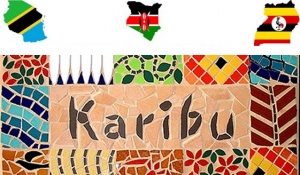Language/Swahili-individual-language/Culture/Popular-Culture
Greetings, students! I am thrilled to take you on this journey through the rich and vibrant culture of Swahili. In previous lessons, we have explored Swahili language from its basic grammar to greetings and introduction, numerals, and other aspects of daily life. In this lesson, we will dive deeper into Swahili literature and art and explore the colorful world of Swahili popular culture. So, buckle up for a fascinating ride!
Don't miss the chance to check out these pages as you wrap up this lesson: Maji and the Maridadi & Sherehe za Mapinduzi.
Swahili Literature and Art
The Swahili culture is known for its rich artistic and literary traditions. People across the world have been captivated by Swahili tales and stories that convey the essence of the culture in a profound way. The Swahili oral tradition has been passed down through generations and has unique literary forms that bear witness to the rich and diverse cultural heritage.
Oral Narratives
Oral narratives are part of the Swahili tradition, and they have retained a vital role in the culture. Folktales, proverbs, riddles, and poetry are all forms of oral narratives that provide insight into the Swahili language and the people who speak it.
One example of a fascinating Swahili folktale is the story of "Kijana wa Salamu na Marafiki Zake" (The Young Man of Salamu and His Friends). This story has been transmitted orally, and it tells the tale of Salamu, a young man who leaves his village to make friends in the city. The story explores themes of family, friendship, and the trials and tribulations of life.
Here is an example of a Swahili proverb that illustrates the rich metaphorical language used in Swahili oral traditions: "Mficha uchi hazai" which means "he who conceals his nakedness does not bear children." This proverb is not meant to be taken literally, but rather it conveys the idea that hiding one's true intentions will not yield results.
Visual Arts
The Swahili people express their creativity through various forms of visual arts. From painting and sculpture to architecture and design, the Swahili people have produced a wide range of exquisite pieces that reflect their identity and values.
Sculptures have always been an important part of Swahili art, religious sculptures, like wooden figures of saints and angels, were once located in households, and still play an active role in local religious places. Another example is Tinga Tinga art, which originated in Tanzania and has become a popular visual art form that uses oil paints.
In architecture, Swahili style is notable for its intricate use of decorative and geometric designs such as the use of ornamental niches that are used in coastal buildings, popularly called "zidaka".
Contemporary Literature
While the Swahili oral tradition has retained its significance, a growing number of contemporary writers are using the written word to express their creativity. Swahili novels, poetry, and lyrics illustrate how art is evolving and adapting to modern times.
One prominent novelist is Kenyan writer Ngũgĩ wa Thiong'o, whose works, including "Weep Not, Child" and "Petals of Blood" have been translated into various languages across the world. Additionally, poets like Shaaban Robert, Afzal Ahmed, and others are making significant contributions to the Swahili literary scene with their incredibly rich poems and prose.
Popular Culture
Swahili popular culture is rich and diverse, and it reflects the vibrant energy of the people who speak the language. Swahili music, film, and television programs are among the most popular in East Africa, and they appeal to people of all ages and social backgrounds. Let's explore each of these in more detail.
Music
Swahili music, also known as "muziki wa dansi" or dance music, is popular throughout East Africa. With its infectious rhythms, catchy melodies, and uplifting lyrics, Swahili music reflects the joys, sorrows, and daily life of the Swahili people.
One of the most popular Swahili musicians is Mbaraka Mwinshehe, who was known as the “king of Swahili music." His most famous song, "Nyama Choma," is a favorite among many music lovers. Other well-known Swahili musicians are Bi Kidude, Remmy Ongala, and Ali Kiba.
Film
The film industry in East Africa is small but growing, and Swahili-language films are gaining more attention than ever before. Swahili films, also known as "Bongo movies," have evolved significantly over the years, from their humble beginnings as low-budget productions to the more sophisticated and compelling movies that are being produced today.
One of the most famous Swahili language films is "From a Whisper," a Kenyan film that tells the story of the 1998 bombing of the US embassy in Nairobi. Other popular Swahili films are "Safari ya Gwalu," "Azali," and "Sitta Unga'ni."
Television
Swahili television programming is also experiencing tremendous growth across East Africa. Swahili-language news programs, talk shows, and soap operas are among the most popular programs, and they cater to a variety of tastes and interests.
One popular Swahili soap opera is "Moyo", which aired in Tanzania in 2010. The show explored themes of love, relationships, and family struggles in a way that was both entertaining and thought-provoking. Other popular Swahili TV shows include "Mikasi Mpya," "Papa," and "Shuga."
In conclusion, Swahili literature and art are thriving, driven by a rich and vibrant cultural heritage that has been passed down through generations of Swahili speakers. Whether it is through oral narratives, visual art, or contemporary literature, Swahili artists are leaving their mark on the world. And as Swahili popular culture continues to grow, it reflects the spirit and creativity of the Swahili people, making it a truly exciting and dynamic aspect of the culture.
Thank you all for joining me on this journey. I hope you found it both interesting and informative. See you in the next lesson!
Other Lessons
- Contemporary Literature
- Religion and Beliefs
- Oral Narratives
- History of Swahili
- Music and Dance
- Maji and the Maridadi
- Ramadan and Eid al Fitr
- Visual Arts
- Sherehe za Mapinduzi

